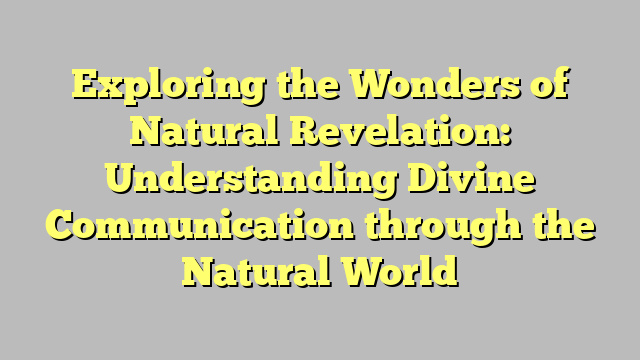Exploring the Wonders of Natural Revelation: Understanding Divine Communication through the Natural World
Exploring the Wonders of Natural Revelation: Understanding Divine Communication through the Natural World
Natural revelation refers to the understanding of the divine and the spiritual realm through the observation of the natural world. It is a concept embraced by many religious and philosophical traditions, suggesting that nature itself is a form of communication from the divine, offering insights into the character, attributes, and intentions of a higher power. This article delves into the wonders of natural revelation, exploring how the natural world communicates divine messages and what we can learn from them.
The Concept of Natural Revelation
Natural revelation is the idea that the divine can be understood through the natural world. Unlike special revelation, which involves direct communication from the divine through sacred texts, prophets, or mystical experiences, natural revelation is available to everyone, everywhere, at all times. It suggests that by observing the world around us—the complexity of a single cell, the majesty of a mountain range, or the vastness of the universe—we can gain insights into the nature of the divine.
Historical Perspectives
Throughout history, many philosophers and theologians have discussed the concept of natural revelation. Ancient Greek philosophers like Aristotle saw the order and purpose in nature as evidence of a divine intelligence. In the Christian tradition, the Apostle Paul argued in his letter to the Romans that the qualities of God are visible through His creation. Similarly, Islamic scholars have pointed to the signs (Ayat) in the natural world as indicators of Allah’s presence and attributes.
Understanding Divine Communication through Nature
Divine communication through nature can be subtle and requires an open heart and mind to interpret. Here are some ways in which the natural world communicates divine messages:
Beauty and Awe
- The breathtaking beauty of a sunset or the serene calm of a forest can evoke a sense of awe and wonder, suggesting the presence of something greater than ourselves.
- This emotional response can be seen as a form of communication, encouraging us to reflect on our place in the universe and the existence of a higher power.
Order and Complexity
- The intricate order and complexity found in nature, from the DNA molecule to the ecosystems, can suggest intelligent design.
- This complexity can lead to contemplation about the origins of life and the universe, pointing towards a divine creator.
Universal Morality
- Nature often demonstrates principles that many consider to be morally significant, such as cooperation, sacrifice, and nurturing.
- These natural principles can be interpreted as divine messages about how we should live and treat one another.
Examples of Natural Revelation
Here are some specific examples of how natural revelation can manifest:
| Example | Description |
|---|---|
| The Fibonacci Sequence in Nature | This mathematical sequence appears in various natural formations, such as the arrangement of leaves, the patterns of flower petals, and the spirals of galaxies, suggesting a universal order. |
| The Water Cycle | The cycle of evaporation, condensation, and precipitation demonstrates a system of renewal and sustenance, which can be seen as a metaphor for spiritual rebirth and cleansing. |
| Animal Behavior | Instances of altruism and cooperation in the animal kingdom can inspire humans to reflect on the values of compassion and community. |
Interpreting Natural Revelation
Interpreting the messages conveyed through natural revelation is a deeply personal and subjective experience. It often requires reflection, meditation, and an openness to the possibility of the divine. While some may see the hand of a creator in the complexity and beauty of the natural world, others may interpret these phenomena through the lens of science and natural laws. The key to understanding natural revelation lies in the willingness to explore and contemplate the mysteries of the universe.
Challenges in Interpretation
One of the challenges in interpreting natural revelation is the risk of projecting human desires and biases onto the natural world. It’s important to approach natural revelation with humility, recognizing that our understanding is limited and that the divine may transcend human comprehension.
Conclusion
Exploring the wonders of natural revelation opens up a fascinating avenue for understanding divine communication. By observing and reflecting on the natural world, we can gain insights into the nature of the divine, the universe, and our place within it. Whether through the awe-inspiring beauty of a landscape, the intricate complexity of biological systems, or the moral lessons evident in nature, the natural world is a rich source of spiritual inspiration and revelation.

